Dairy’s Development and Socio-Economic Transformation: A Cross-Country Analysis
Abstract
1. Introduction
Agriculture Development and Its Social Implications
2. Materials and Methods
3. Results
3.1. Farmers’ Livelihoods
- Stylized fact no. 1. Decreasing presence of dairy farm households in population.
- Stylized fact no. 2. Higher income for dairy farm households.
3.2. Employment
- Stylized fact no. 3. Higher milk yield correlates with fewer people working on dairy farms.
- Stylize fact no. 4. Rising farm labour productivity.
- Stylized fact no. 5. Employment in dairy processing facilities (pervasiveness, share in population) first rises, then declines and stabilizes as the sector matures.
- Stylized fact no. 6. Wages in milk processing increase with sector development.
3.3. Consumers
- Stylized fact no. 7. Milk supply per capita increases, as the sector develops.
- Stylized fact no. 8. More people access and consume dairy products.
- Stylized fact no. 9. Greater benefits for consumers through lower prices.
- Stylized fact no. 10. More affordable milk as the sector develops.
3.4. Governments’ Benefits
- Stylized fact no. 11. Dairy’s contribution to agricultural value addition increases with sector development.
- Stylized fact no. 12. Potential tax base (income) increases.
- Stylized fact no. 13. Potential tax base (consumption) increases.
- Stylized fact no. 14. Formality in the sector growths.
4. Different Regions and Systems
5. Conclusions and Recommendations
Policy Recommendations
- Assessing the nutritional status of the population and examining the role of the dairy sector in improving nutrition (drawing on information from healthcare providers, hospitals, etc.). Policy makers could identify how the dairy sector could contribute to better nutrition and which actions should be taken to promote and enhance nutrition.
- Possibilities of public–private partnerships.
Supplementary Materials
Author Contributions
Funding
Institutional Review Board Statement
Informed Consent Statement
Data Availability Statement
Conflicts of Interest
Abbreviations
| SDGs | Sustainable Development Goals |
| UN | United Nations |
| GR | Green Revolution |
| GASL | Global Agenda for Sustainable Livestock |
| FAO | Food and Agriculture Organization of the United Nations |
| IFCN | International Farm Comparison Network |
| IFAD | International Fund for Agricultural Development |
| GDP | Global Dairy Platform |
| IPL | International Poverty Line |
| GDP | Gross Domestic Product |
| WB | World Bank |
| ILO | International Labour Organization |
| UNPF | United Nations Population Fund |
| UNIDO | United Nations Industrial Development Organization |
| LCU | Local Currency Unit |
| PPP | Purchasing Power Parity |
| WoS | Web of Science |
References
- FAOSTAT. Food and Agriculture Data. Available online: https://www.fao.org/faostat/en/#data (accessed on 11 October 2023).
- GASL. Dairy and Socio-Economic Development. In What Evidence Does the Data Hold; GASL: Rome, Italy, 2024. [Google Scholar]
- FAO. The State of Food and Agriculture 2022; FAO: Rome, Italy, 2022. [Google Scholar] [CrossRef]
- FAO. Milk Facts. Available online: https://www.fao.org/3/I9966EN/i9966en.pdf (accessed on 5 February 2025).
- OECD-FAO. OECD-FAO Agricultural Outlook 2024–2033; OECD: Paris, France, 2024. [Google Scholar] [CrossRef]
- Bojovic, M.; McGregor, A. A review of megatrends in the global dairy sector: What are the socioecological implications? Agric. Hum. Values 2023, 40, 373–394. [Google Scholar] [CrossRef]
- FAO; GDP; IFCN. Dairy’s Impact on Reducing Global Hunger; FAO; GDP; IFCN: Chicago, IL, USA, 2020; Available online: http://www.fao.org/3/ca7500en/CA7500EN.pdf (accessed on 1 January 2025).
- FAO; GDP; IFCN. Dairy Development’s Impact on Poverty Reduction; FAO; GDP; IFCN: Chicago, IL, USA, 2018; Available online: http://www.fao.org/3/ca0289en/ca0289en.pdf (accessed on 1 January 2025).
- Dror, D.K.; Allen, L.H. The Importance of Milk and other Animal-Source Foods for Children in Low-Income Countries. Food Nutr. Bull. 2011, 32, 227–243. [Google Scholar] [CrossRef] [PubMed]
- FAO. Milk and Dairy Product in Human Nutrition; Food and Agriculture Organization of the United Nations: Rome, Italy, 2013; Available online: http://www.fao.org/3/i3396e/i3396e.pdf (accessed on 7 July 2025).
- Hoddinott, J.; Headey, D.; Cows, M.D.; Markets, M.M. Nutrition in Rural Ethiopia. J. Dev. Stud. 2015, 51, 958–975. [Google Scholar] [CrossRef]
- Dethier, J.J.; Effenberger, A. Agriculture and development: A brief review of the literature. Econ. Syst. 2012, 36, 175–205. [Google Scholar] [CrossRef]
- Irz, X.; Lin, L.; Thirtle, C.; Wiggins, S. Agricultural Productivity Growth and Poverty Alleviation. Dev. Policy Rev. 2001, 19, 449–466. [Google Scholar] [CrossRef]
- Mozumdar, L. Agricultural productivity and food security in the developing world. Bangladesh J. Agric. Econ. 2012, 35, 53–69. [Google Scholar] [CrossRef]
- Pingali, P.L. Green Revolution: Impacts, limits, and the path ahead. Proc. Natl. Acad. Sci. USA 2012, 109, 12302–12308. [Google Scholar] [CrossRef]
- Barrett, C.B. The Economics of Agricultural Development: An Overview. Orig. Essay 2011, 1–63. Available online: http://barrett.dyson.cornell.edu/Books/Introduction%20Chapter%201%208June2011%20Revised%20Final%20Version.pdf (accessed on 25 April 2024).
- Hazell, P.B.R. The Asian Green Revolution. In Proven Successes in Agricultural Development. A Technical Compedium to Million Fed; Spielman, D.J., Pandya-Lorch, R., Eds.; International Food Policy Research Institute: Washington, DC, USA, 2010; Volume 3, pp. 67–98. [Google Scholar]
- Fuglie, K.; Gautam, M.; Goyal, A.; Maloney, W.F. Harvesting Prosperity: Technology and Productivity Growth in Agriculture; World Bank: Washington, DC, USA, 2020. [Google Scholar] [CrossRef]
- Webb, P. More food, but not yet enough: 20th century successes in agriculture growth and 21st century challenges. In Fiat Panis: For a World Without Hunger; Eiselen, H., Ed.; Hampp Media/Balance Publications: Stuttgart, Germany, 2009; pp. 410–434. [Google Scholar]
- Fan, S.; Brzeska, J. Production, Productivity, and Public Investment in East Asian Agriculture. In Handbook of Agricultural Economics; Gardner, G.C., Rausser, P.L., Pingali, R.E., Robert, E., Eds.; Elsevier: Amsterdam, The Netherlands, 2010; Volume 4, pp. 3401–3434. [Google Scholar] [CrossRef]
- Hazell, P.B.R. An Assessment of the Impact of Agricultural Research in South Asia Since the Green Revolution. In Handbook of Agricultural Economics; Gardner, G.C., Rausser, P.L., Pingali, R.E., Robert, E., Eds.; Elsevier: Amsterdam, The Netherlands, 2010; Volume 4, pp. 3469–3530. [Google Scholar] [CrossRef]
- Timmer, C.P. Getting agriculture moving: Do markets provide the right signals? Food Policy 1995, 20, 455–472. [Google Scholar] [CrossRef]
- Pingali, P. Agricultural Mechanization: Adoption Patterns and Economic Impact. In Handbook of Agricultural Economics; Evenson, R.E., Pingali, P., Eds.; Elsevier: Amsterdam, The Netherlands, 2007; Volume 3, pp. 2779–2805. [Google Scholar] [CrossRef]
- World Bank. 2007 World Development Report 2008: Agriculture for Development; World Development Report: Washington, DC, USA, 2007. [Google Scholar] [CrossRef]
- Mellor, J.W. The New Economics of Growth: A Strategy for India and the Developing World; Cornell University Press: Ithaca, NY, USA, 1976. [Google Scholar]
- Thirtle, C.; Lin, L.; Piesse, J. The Impact of Research-Led Agricultural Productivity Growth on Poverty Reduction in Africa, Asia and Latin America. World Dev. 2003, 31, 1959–1975. [Google Scholar] [CrossRef]
- Ravallion, M.; Datt, G. How Important to India’s Poor Is the Sectoral Composition of Economic Growth? World Bank Econ. Rev. 1996, 10, 1–25. [Google Scholar] [CrossRef]
- Torlesse, H.; Kiess, L.; Bloem, M.W. Association of household rice expenditure with child nutritional status indicates a role for macroeconomic food policy in combating malnutrition. J. Nutr. 2003, 133, 1320–1325. [Google Scholar] [CrossRef] [PubMed]
- Timmer, P.C. The agricultural transformation. In Handbook of Development Economics; Elsevier: Amsterdam, The Netherlands, 1988; Volume 1, pp. 275–331. [Google Scholar] [CrossRef]
- Christiaensen, L.; Demery, L.; Kuhl, J. The (evolving) role of agriculture in poverty reduction—An empirical perspective. J. Dev. Econ. 2011, 96, 239–254. [Google Scholar] [CrossRef]
- Fan, S.; Hazell, P. Returns to Public Investments in the Less-Favored Areas of India and China. Am. J. Agric. Econ. 2001, 83, 1217–1222. [Google Scholar] [CrossRef]
- Evenson, R.E.; Gollin, D. Assessing the Impact of the Green Revolution, 1960 to 2000. Science 2003, 300, 758–762. [Google Scholar] [CrossRef] [PubMed]
- Pinstrup-Andersen, P.; Hazell, P.B.R. The impact of the green revolution and prospects for the future. Food Rev. Int. 1985, 1, 1–25. [Google Scholar] [CrossRef]
- FAO. Guidelines for the Measurement of Productivity and Efficiency in Agriculture; FAO: Rome, Italy, 2018; Available online: http://www.fao.org/3/ca6395en/ca6395en.pdf (accessed on 16 May 2024).
- Buchanan, M. It’s a (stylized) fact! Nat. Phys. 2012, 8, 3. [Google Scholar] [CrossRef]
- Kaldor, N. Capital Accumulation and Economic Growth. In The Theory of Capital; Palgrave Macmillan: London, UK, 1961; pp. 177–222. [Google Scholar] [CrossRef]
- Black, J.; Hashimzade, N.; Myles, G. A Dictionary of Economics; Oxford University Press: Oxford, UK, 2009. [Google Scholar] [CrossRef]
- Michler, J.D. Agriculture in the process of development: A micro-perspective. World Dev. 2020, 129, 104888. [Google Scholar] [CrossRef]
- Jacoby, W.G. Loess: A nonparametric, graphical tool for depicting relationships between variables. Elect. Stud. 2000, 19, 577–613. [Google Scholar] [CrossRef]
- Racine, J.S. Nonparametric Econometrics: A Primer. Found. Trends® Econom. 2007, 3, 1–88. [Google Scholar] [CrossRef]
- Henderson, D.J.; Parmeter, C.F. Applied Nonparametric Econometrics; Cambridge University Press: Cambridge, UK, 2015. [Google Scholar] [CrossRef]
- Cleveland, W.S. Robust locally weighted regression and smoothing scatterplots. J. Am. Stat. Assoc. 1979, 74, 829–836. [Google Scholar] [CrossRef]
- Cleveland, W.S.; Devlin, S.J. Locally weighted regression: An approach to regression analysis by local fitting. J. Am. Stat. Assoc. 1988, 83, 596–610. [Google Scholar] [CrossRef]
- Eurostat. Farmers and the Agricultural Labour Force—Statistics. Available online: https://ec.europa.eu/eurostat/statistics-explained/index.php?title=Farmers_and_the_agricultural_labour_force_-_statistics#Fewer_farms.2C_fewer_farmers (accessed on 24 May 2024).
- Lowder, S.K.; Skoet, J.; Singh, S. What Do We Really Know About the Number and Distribution of Farms and Family Farms in the World? Background Paper for the State of Food and Agriculture 2014; FAO: Rome, Italy, 2014; Available online: https://ageconsearch.umn.edu/record/288983/ (accessed on 27 April 2024).
- Pinstrup-Andersen, P.; Pandya-Lorch, R. Food security and sustainable use of natural resources: A 2020 Vision. Ecol. Econ. 1998, 26, 1–10. [Google Scholar] [CrossRef]
- Datt, G.; Ravallion, M. Farm productivity and rural poverty in India. J. Dev. Stud. 1998, 34, 62–85. [Google Scholar] [CrossRef]
- Kuznets, S. Modern Economic Growth. Rate, Structure, and Spread; Yale University Press: New Haven, CT, USA, 1966. [Google Scholar]
- Hazell, P.B.R. The Impact of Agricultural Research on the Poor: A Review of the State of Knowledge. In Agricultural Research and Poverty Reduction Some Issues and Evidence; Mathur, S., Pachico, D., Eds.; International Center for Tropical Agriculture (CIAT): Cali, Colombia, 2003. [Google Scholar]
- Lipton, M.; Longhurst, R. New Seeds and Poor People; Routledge Taylor & Francis Group: London, UK, 1989. [Google Scholar] [CrossRef]
- Gollin, D. Chapter 73 Agricultural Productivity and Economic Growth. In Handbook of Agricultural Economics; Elsevier: Amsterdam, The Netherlands, 2010; Volume 4, pp. 3825–3866. [Google Scholar] [CrossRef]
- Heston, A.; Summers, R.; Aten, B. Penn World Tables Version 6.2—Center for International Comparisons of Production, Income and Prices at the University of Pennsylvania; University of Pennsylvania: Philadelphia, PA, USA, 2006; Available online: https://datacentre.chass.utoronto.ca/pwt62/ (accessed on 26 April 2024).
- Dorward, A. Agricultural labour productivity, food prices and sustainable development impacts and indicators. Food Policy 2013, 39, 40–50. [Google Scholar] [CrossRef]
- Briones, R.; Felipe, J. Agriculture and structural transformation in developing Asia: Review and outlook. In Asian Development Bank Economics Working Paper Series; Asian Development Bank: Manila, Philippines, 2013; Volume 363, Available online: https://papers.ssrn.com/sol3/papers.cfm?abstract_id=2321525 (accessed on 16 May 2024).
- Yangfen, C.; Xiande, L.; Yu, L. Increasing China’s Agricultural Labor Productivity: Comparison and Policy Implications from Major Agrarian Countries. J. Resour. Ecol. 2018, 9, 575–584. [Google Scholar] [CrossRef]
- Herrendorf, B.; Rogerson, R.; Valentinyi, Á. Growth and Structural Transformation. Handb. Econ. Growth 2014, 2, 855–941. [Google Scholar] [CrossRef]
- Alston, J.M.; Norton, G.W.; Pardey, P.G. Science Under Scarcity: Principles and Practice for Agricultural Research Evaluation and Priority Setting; Cornell University Press for the International Service for National Agricultural Research (ISNAR): London, UK; Ithaca, NY, USA, 1995; Available online: https://hdl.handle.net/10568/136536 (accessed on 17 May 2024).
- Hazell, P.; Ramasamy, C. The Green Revolution Reconsidered: The Impact of High-Yielding Rice Varieties in South India; Johns Hopkins Univ Press: Baltimore, MD, USA, 1991; Available online: https://www.cabidigitallibrary.org/doi/full/10.5555/19921894419 (accessed on 17 May 2024).
- Lipton, M. Learning from others: Increasing agricultural productivity for human development in Sub-Saharan Africa. In United Nations Development Programme; Regional Bureau for Africa; Working Paper 7; Addis Ababa, Ethiopia, 2012; Available online: https://www.undp.org/sites/g/files/zskgke326/files/migration/africa/Agricultural-Learning.pdf (accessed on 25 April 2024).
- Conceição, P.; Levine, S.; Lipton, M.; Warren-Rodríguez, A. Toward a food secure future: Ensuring food security for sustainable human development in Sub-Saharan Africa. Food Policy 2016, 60, 1–9. [Google Scholar] [CrossRef]
- Villacis, A.H.; Mayorga, J.; Mishra, A.K. Experience-based food insecurity and agricultural productivity in Nigeria. Food Policy 2022, 113, 102286. [Google Scholar] [CrossRef]
- Kearney, J. Food consumption trends and drivers. Philos. Trans. R. Soc. B Biol. Sci. 2010, 365, 2793–2807. [Google Scholar] [CrossRef] [PubMed]
- FAO; IFAD; UNICEF; WFP; WHO. The State of Food Security and Nutrition in the World 2020. Transforming Food Systems for Affordable Healthy Diets; FAO; IFAD; UNICEF; WFP; WHO: Rome, Italy, 2020. [Google Scholar] [CrossRef]
- Herforth, A.; Bai, Y.; Venkat, A.; Mahrt, K.; Ebel, A.; Masters, W.A. Cost and affordability of healthy diets across and within countries. In Background Paper for The State of Food Security and Nutrition in the World 2020; FAO Agricultural Development Economics Technical Study; FAO: Rome, Italy, 2020; Volume 9. [Google Scholar] [CrossRef]
- Blanco, C.; Raurich, X. Agricultural composition and labor productivity. J. Dev. Econ. 2022, 158, 102934. [Google Scholar] [CrossRef]
- Chavas, J.P. Chapter 5 Structural change in agricultural production: Economics, technology and policy. In Handbook of Agricultural Economics; Elsevier: Amsterdam, The Netherlands, 2001; Volume 1, pp. 263–285. [Google Scholar] [CrossRef]
- Chang, J.J.; Chen, B.-L.; Hsu, M. Agricultural Productivity and Economic Growth: Role of Tax Revenues and Infrastructures. South Econ. J. 2006, 72, 891–914. [Google Scholar] [CrossRef]
- Popoola, O.; Asaleye, A.J.; Eluyela, D.F. Domestic Revenue Mobilization and Agricultural Productivity: Evidence from Nigeria. J. Adv. Res. Law Econ. 2018, IX, 1439–1450. [Google Scholar] [CrossRef] [PubMed]
- Besley, T.; Persson, T. Why Do Developing Countries Tax So Little? J. Econ. Perspect. 2014, 28, 99–120. [Google Scholar] [CrossRef]
- Schneider, F.; Buehn, A.; Montenegro, C.E. Shadow economies all over the world: New estimates for 162 countries from 1999 to 2007. In Handbook on the Shadow Economy; Edward Elgar Publishing: Cheltenham, UK, 2011; pp. 9–77. [Google Scholar] [CrossRef]
- Kouakou, D.C.M.; Yeo, K.I.H. Can Innovation Reduce the Size of the Informal Economy? Evidence from Panel Data. SSRN 2024. [Google Scholar] [CrossRef]
- Feld, L.P.; Schneider, F. Survey on the shadow economy and undeclared earnings in OECD countries. Ger. Econ. Rev. 2010, 11, 109–149. [Google Scholar] [CrossRef]
- Goel, R.K.; Nelson, M.A. Shining a light on the shadows: Identifying robust determinants of the shadow economy. Econ. Model 2016, 58, 351–364. [Google Scholar] [CrossRef]
- La Porta, R.; Shleifer, A. Informality and Development. J. Econ. Perspect. 2014, 28, 109–126. [Google Scholar] [CrossRef]
- Taymaz, E. Informality and Productivity: Productivity Differentials Between Formal and Informal Firms in Turkey; ERC—Economic Research Center, Middle East Technical University: Ankara, Turkey, 2009; Available online: http://erc.metu.edu.tr/en/system/files/menu/series09/0901.pdf (accessed on 29 April 2024).
- FAO. The State of Food and Agriculture. Innovation in Family Farming; FAO: Rome, Italy, 2014; Available online: https://openknowledge.fao.org/handle/20.500.14283/i4040e (accessed on 27 April 2024).
- Lowder, S.K.; Skoet, J.; Raney, T. The Number, Size, and Distribution of Farms, Smallholder Farms, and Family Farms Worldwide. World Dev. 2016, 87, 16–29. [Google Scholar] [CrossRef]
- Duffey, K.J.; Popkin, B.M. Shifts in Patterns and Consumption of Beverages Between 1965 and 2002. Obesity 2007, 15, 2739–2747. [Google Scholar] [CrossRef] [PubMed]
- Cavadini, C.; Siega-Riz, A.M.; Popkin, B.M. US adolescent food intake trends from 1965 to 1996. Arch. Dis. Child. 2000, 83, 18–24. [Google Scholar] [CrossRef] [PubMed]
- Sen Gupta, A. Determinants of Tax Revenue Efforts in Developing Countries; International Monetary Fund: Washington, DC, USA, 2007. [Google Scholar] [CrossRef]
- Nnyanzi, J.B. Main drivers of tax revenue in Uganda: Does the agriculture sector in its current form qualify for taxation? J. Bus. Manag. Appl. Econ. 2015, 4, 1–20. [Google Scholar]
- Schiff, M.; Valdés, A. The Plundering of Agriculture in Developing Countries. Financ. Dev. 1995, 32. Available online: https://www.elibrary.imf.org/view/journals/022/0032/001/article-A013-en.xml (accessed on 24 May 2024).
- Wiggins, S. African Agricultural Development: Lessons and Challenges. J. Agric. Econ. 2014, 65, 529–556. [Google Scholar] [CrossRef]
- Ohnsorge, F.; Yu, S. The Long Shadow of Informality. Challenges and Policies; World Bank Publications: Washington, DC, USA, 2022. [Google Scholar]
- Levenson, A.R.; Maloney, W.F. The informal sector, firm dynamics, and institutional participation. Policy Research Working Paper Series. 1998. Available online: https://ideas.repec.org/p/wbk/wbrwps/1988.html (accessed on 29 April 2024).
- Jaffee, S.; Henson, S.; Unnevehr, L.; Grace, D.; Cassou, E. The Safe Food Imperative: Accelerating Progress in Low- and Middle-Income Countries; World Bank: Washington, DC, USA, 2019. [Google Scholar] [CrossRef]
- FAO. Sustainable Food Systems Concept and Framework Brief; FAO: Rome, Italy, 2018. [Google Scholar]
- Von Braun, J.; Afsana, K.; Fresco, L.; Hassan, M.; Torero, M. Food Systems-Definition, Concept and Application for the UN Food Systems Summit. Sci. Innov. 2020, 27, 27–39. Available online: https://sc-fss2021.org/ (accessed on 3 July 2025).
- Dries, L.; Swinnen, J.F. Foreign direct investment, vertical integration, and local suppliers: Evidence from the Polish dairy sector. World Dev. 2004, 32, 1525–1544. [Google Scholar] [CrossRef]
- ILRI. More Milk by and for the Poor: Adapting Dairy Market Hubs for Pro-Poor Smallholder Value Chains in Tanzania; ILRI: Nairobi, Kenya, 2014. [Google Scholar]
- Gerber, P.J.; Steinfeld, H.; Henderson, B.; Mottet, A.; Opio, C.; Dijkman, J.; Falcucci, A.; Tempio, G.T. Tackling Climate Change Through Livestock. A Global Assessment of Emissions and Mitigation Opportunities; FAO: Rome, Italy, 2013. [Google Scholar]
- Mekonnen, M.M.; Hoekstra, A.Y. A Global Assessment of the Water Footprint of Farm Animal Products. Ecosystems 2012, 15, 401–415. [Google Scholar] [CrossRef]
- FAO. Global Livestock Environmental Assessment Model; FAO: Rome, Italy, 2017. [Google Scholar]
- Herrero, M.; Havlík, P.; Valin, H.; Notenbaert, A.; Rufino, M.C.; Thornton, P.K.; Blümmel, M.; Weiss, F.; Grace, D.; Obersteiner, M. Biomass use, production, feed efficiencies, and greenhouse gas emissions from global livestock systems. Proc. Natl. Acad. Sci. USA 2013, 110, 20888–20893. [Google Scholar] [CrossRef] [PubMed]
- FAO. Pathways Towards Lower Emissions; FAO: Rome, Italy, 2023. [Google Scholar] [CrossRef]
- Pathways to Dairy Net Zero. Available online: https://pathwaystodairynetzero.org/ (accessed on 5 February 2025).
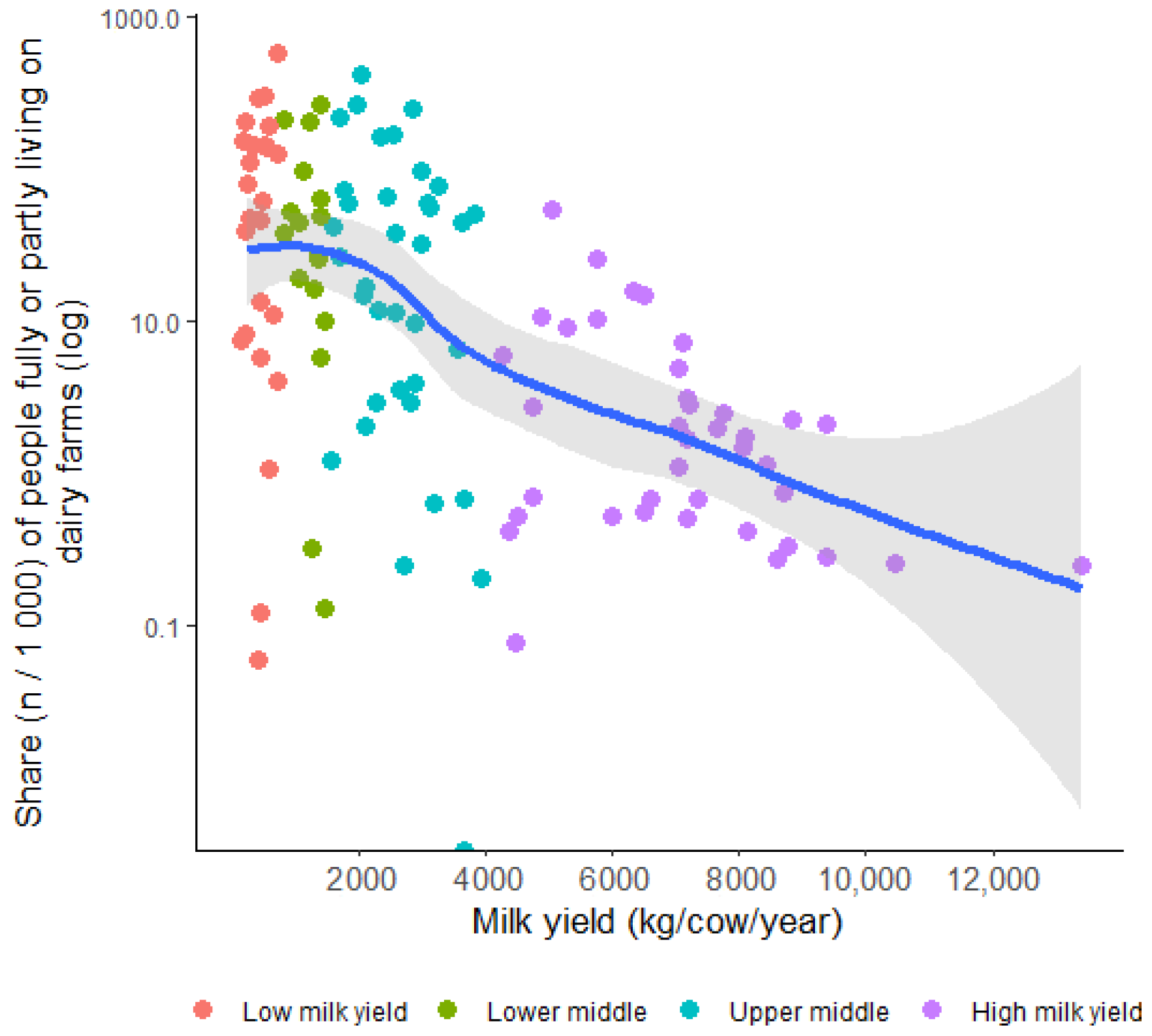
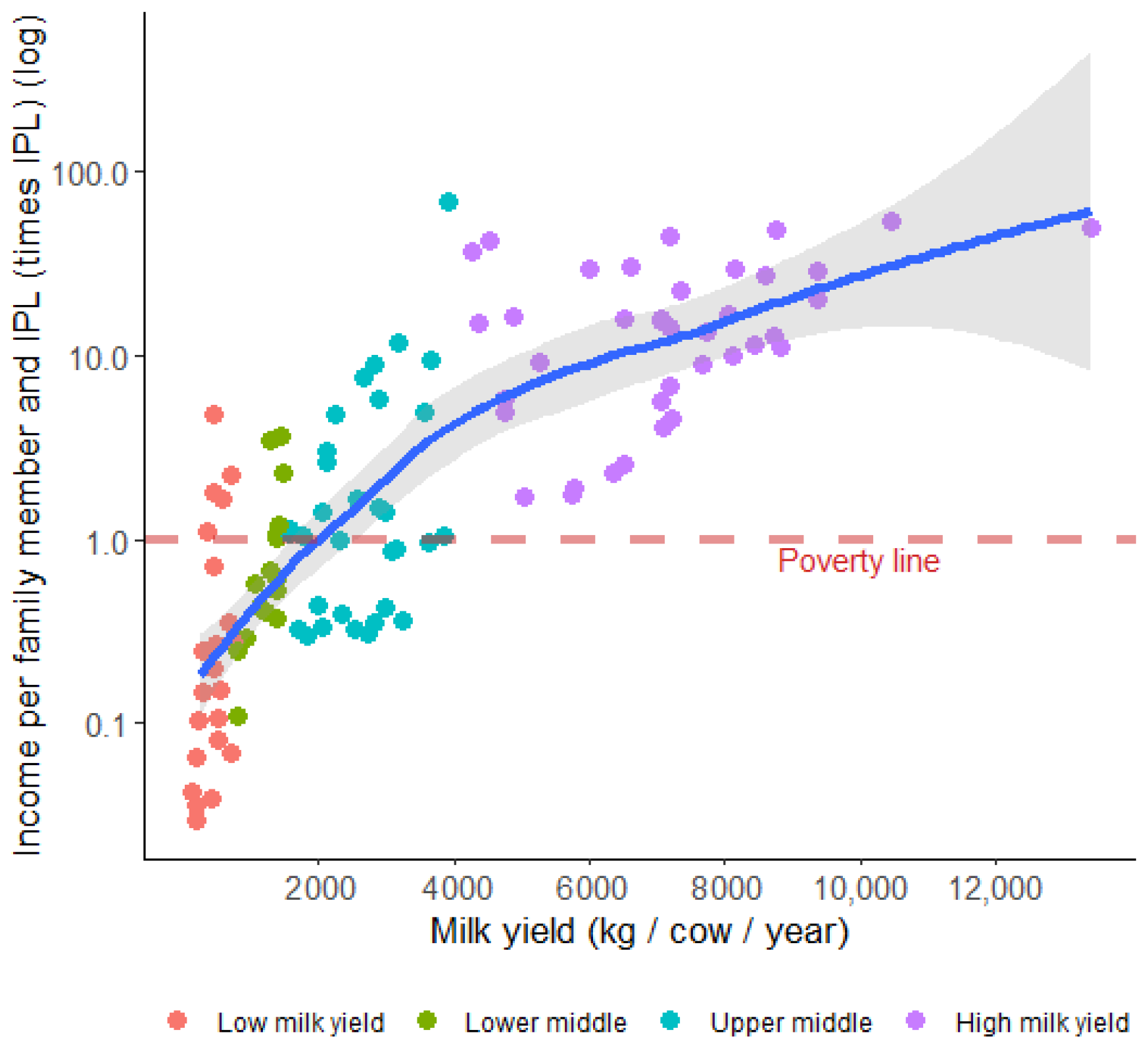
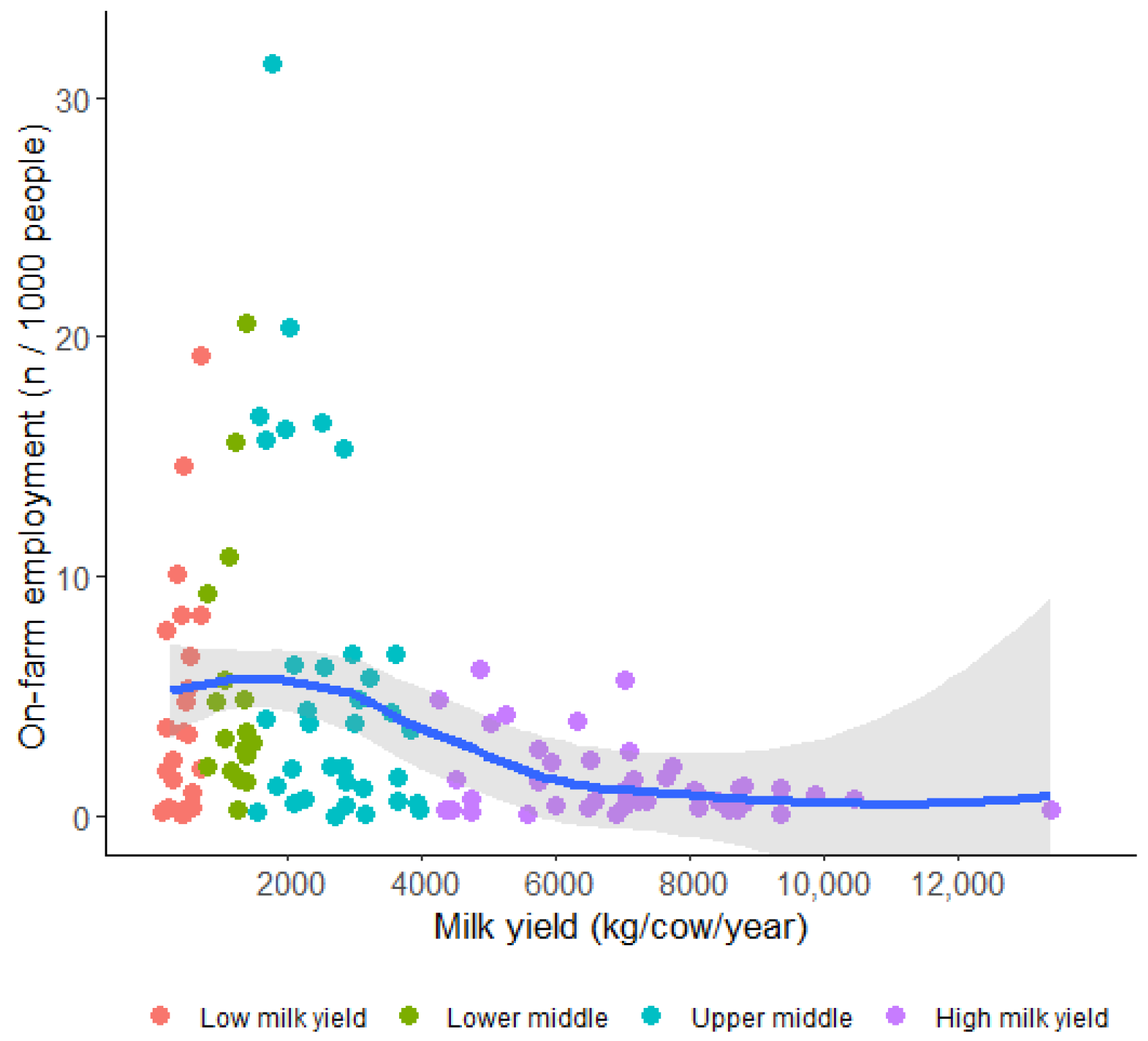
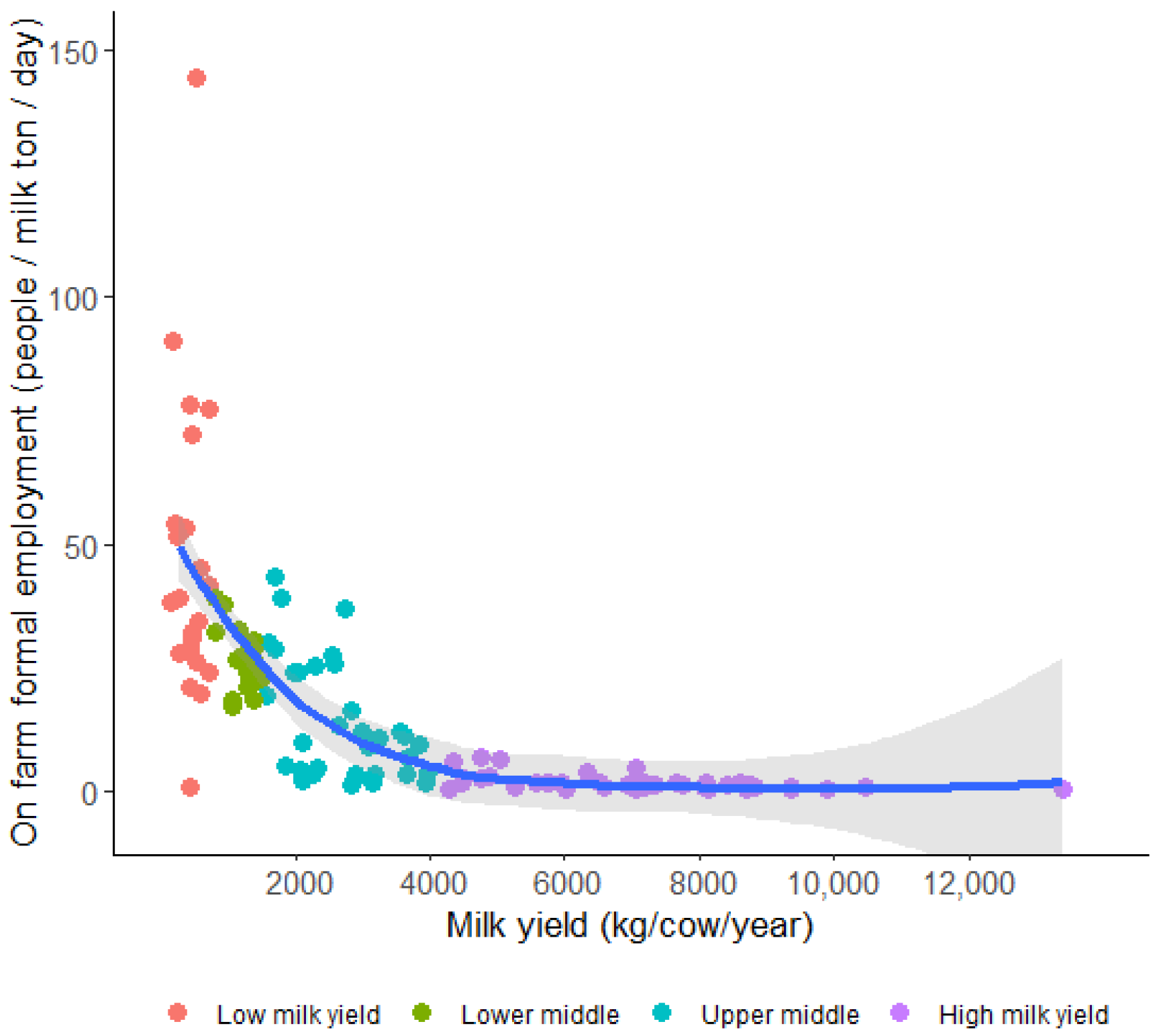
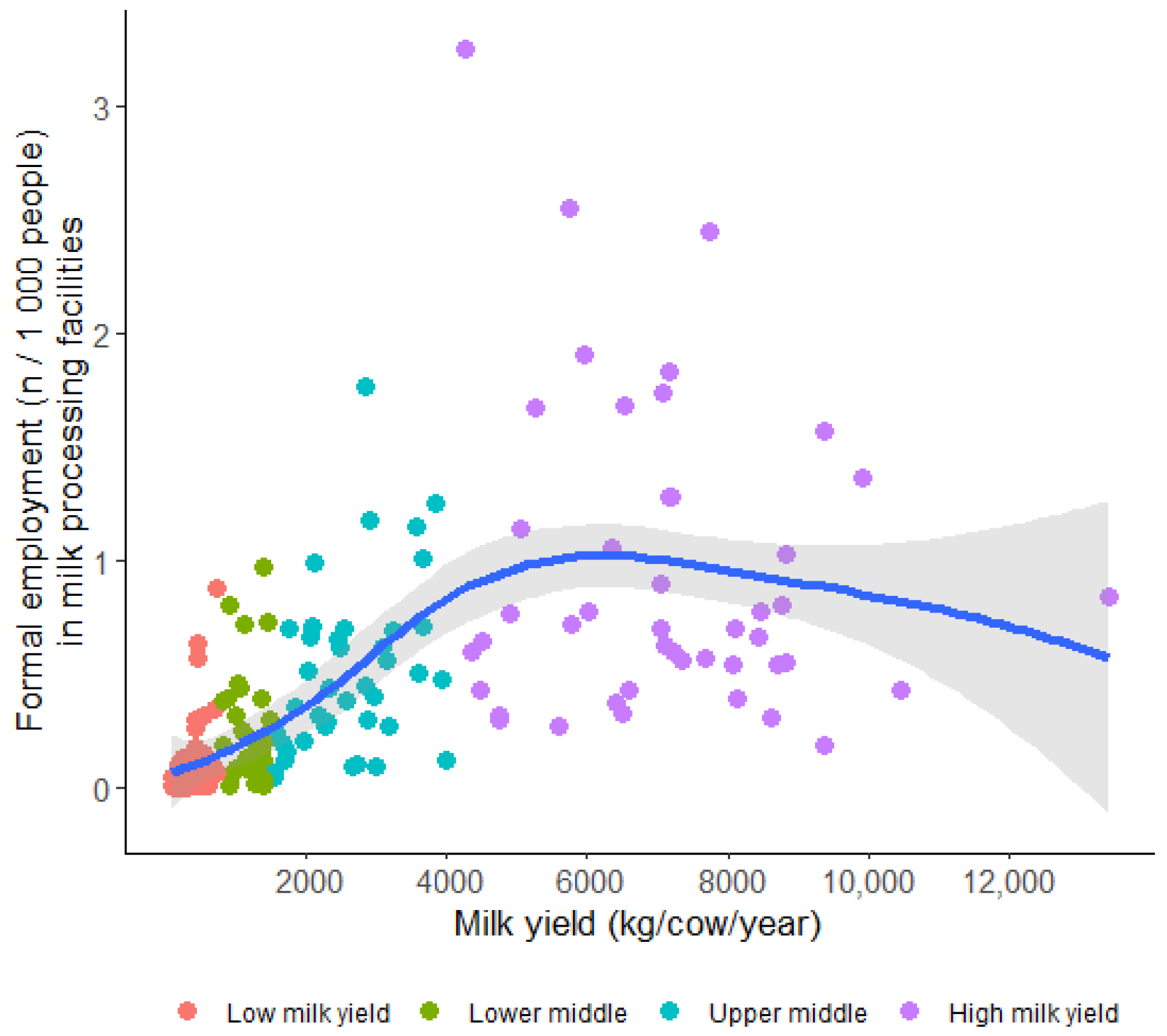
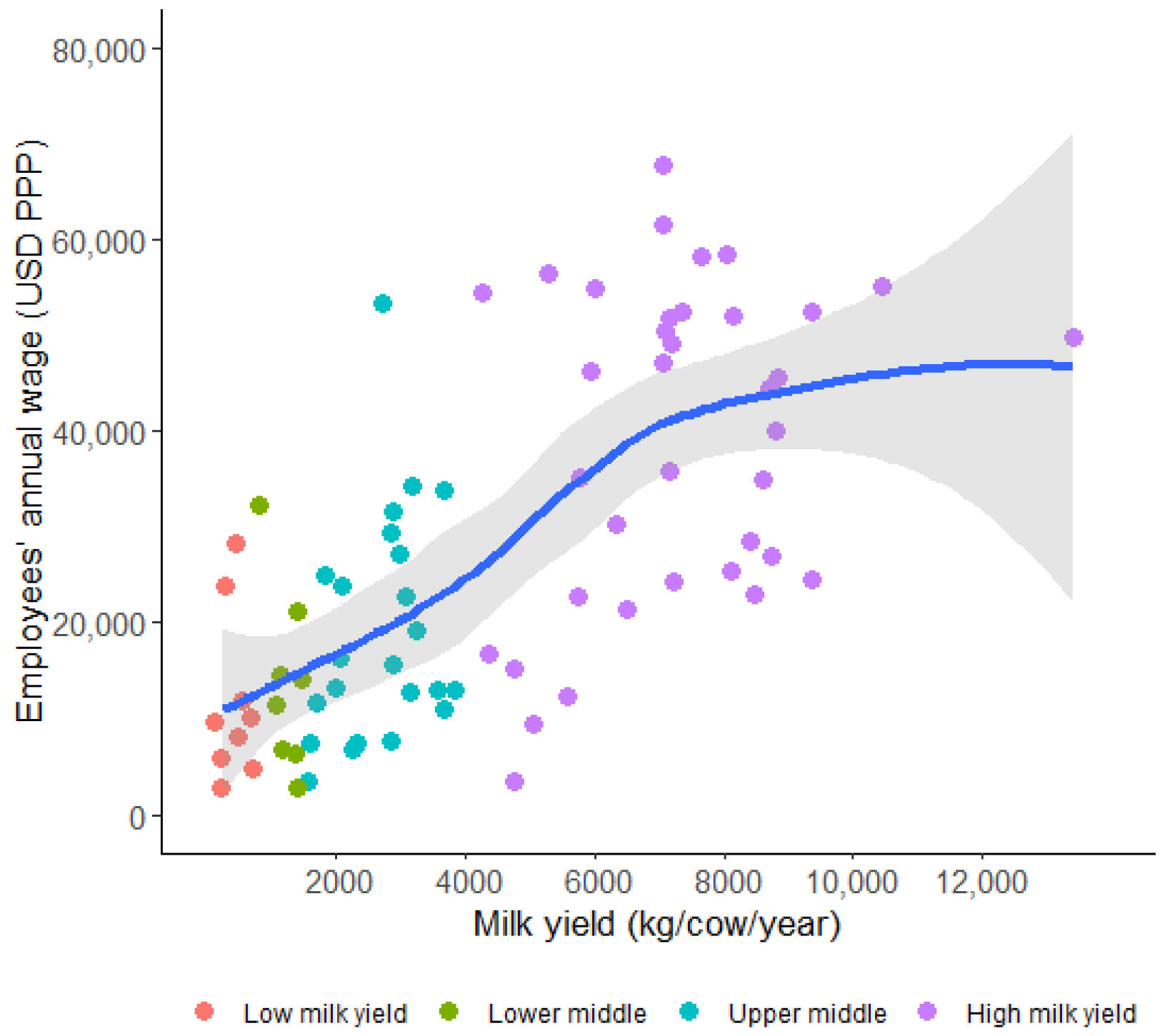
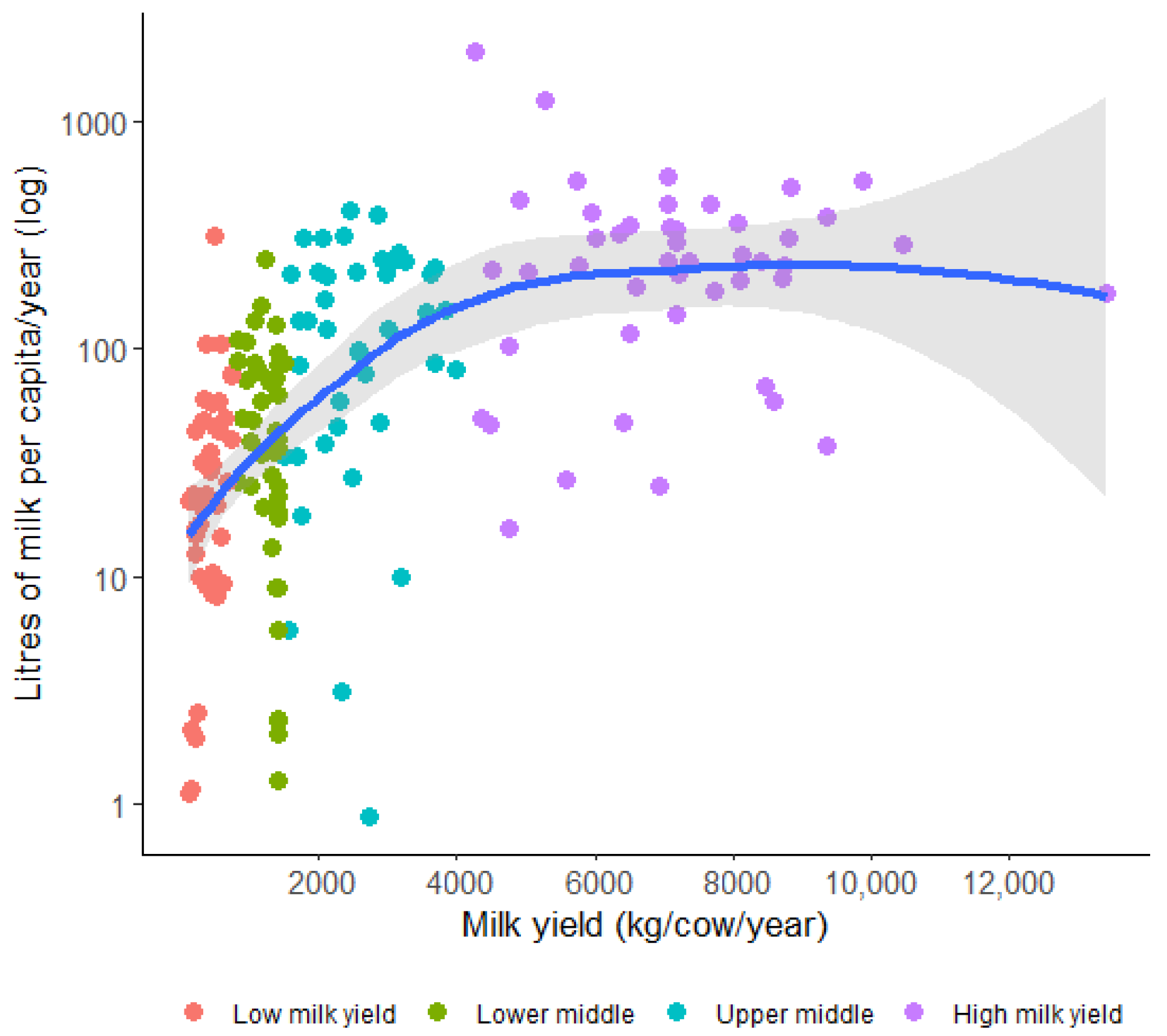
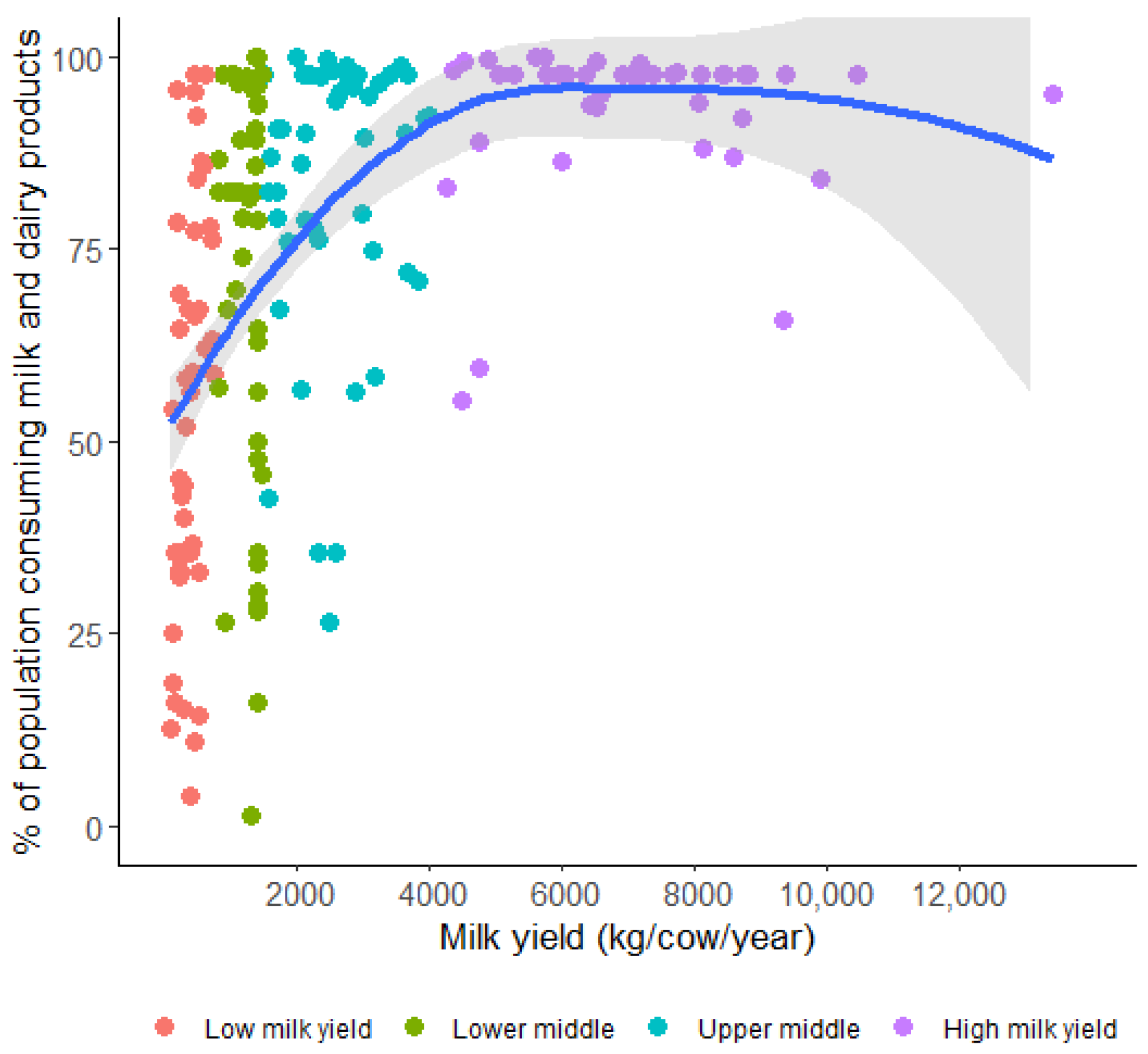
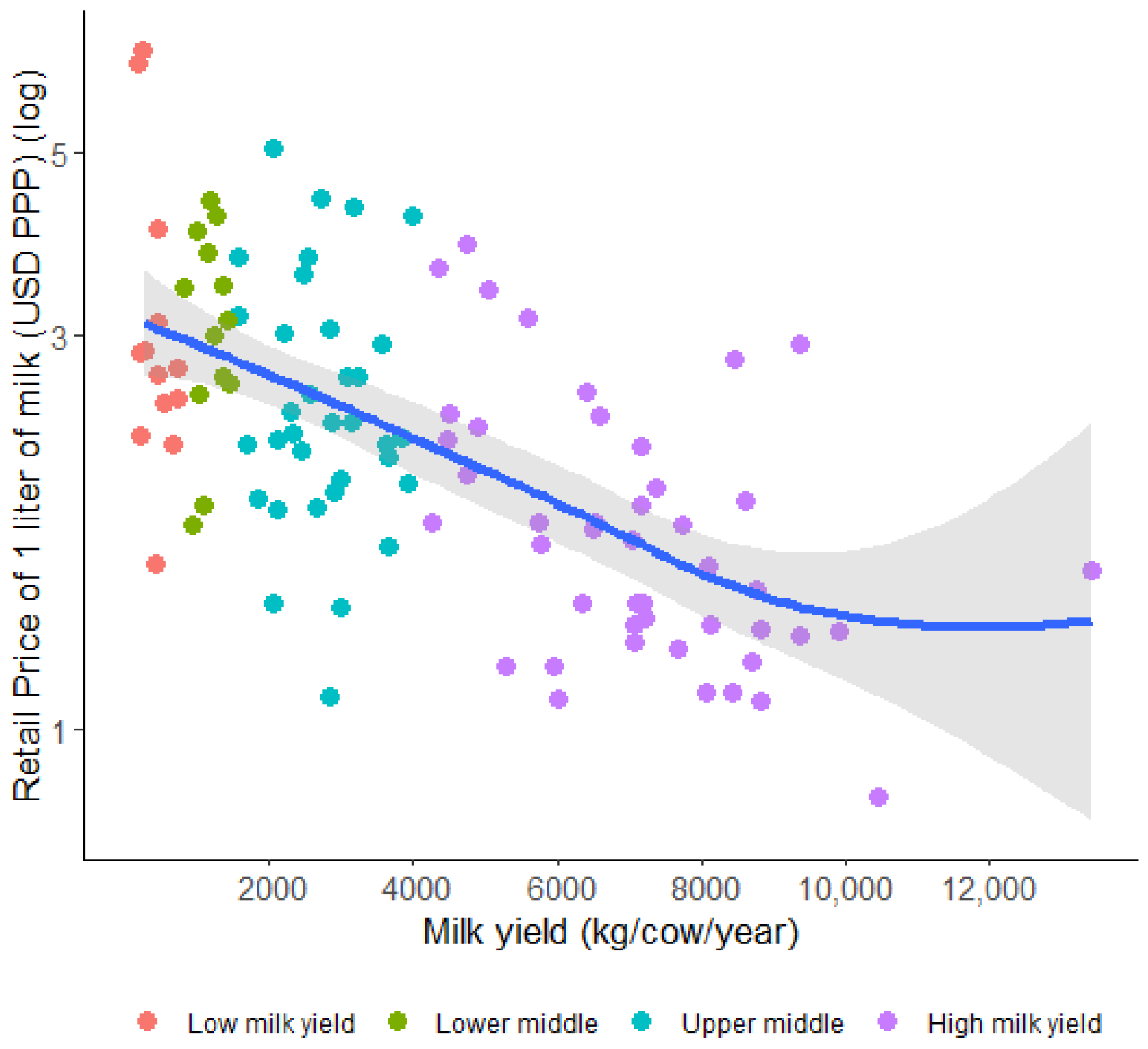
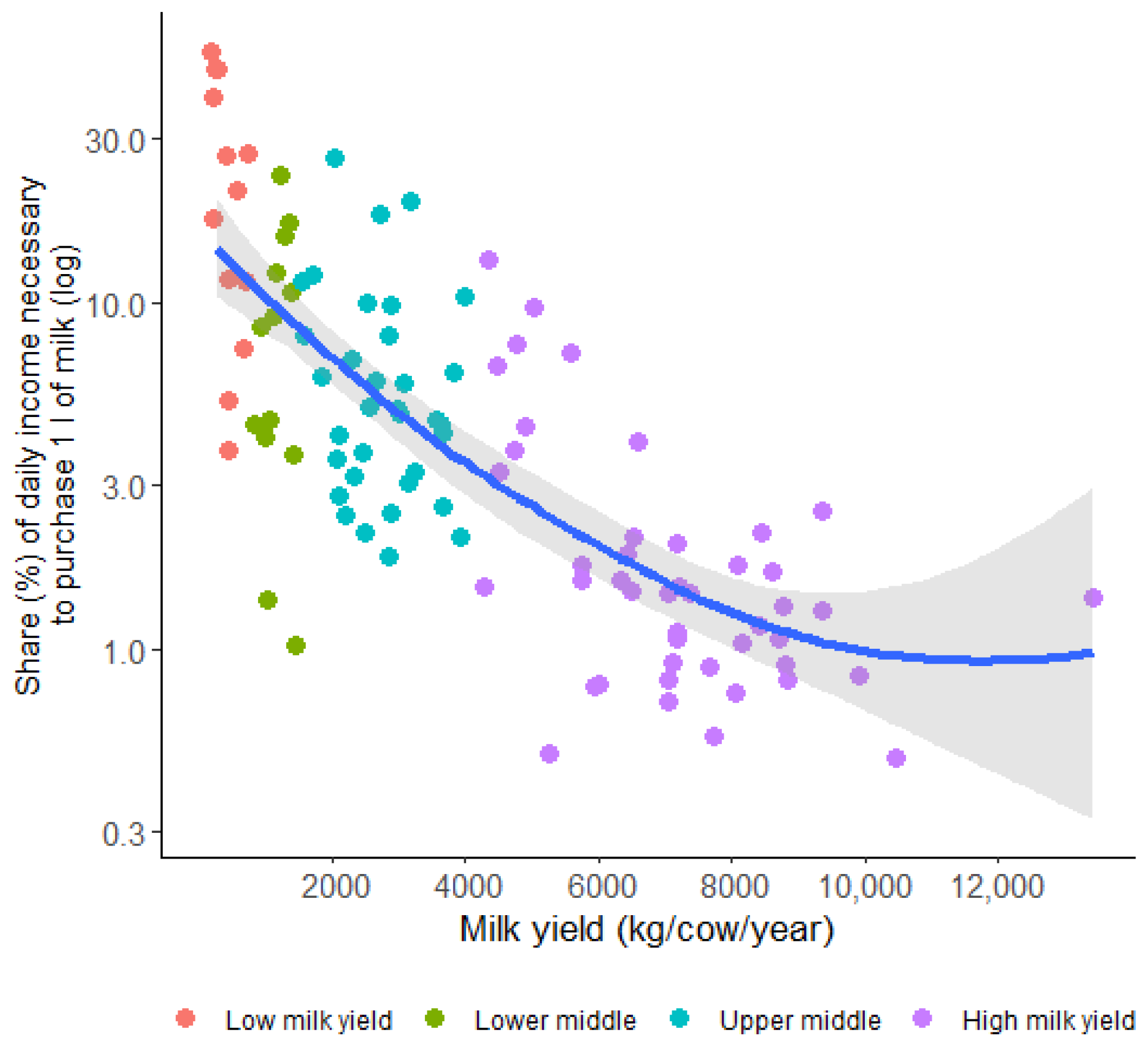
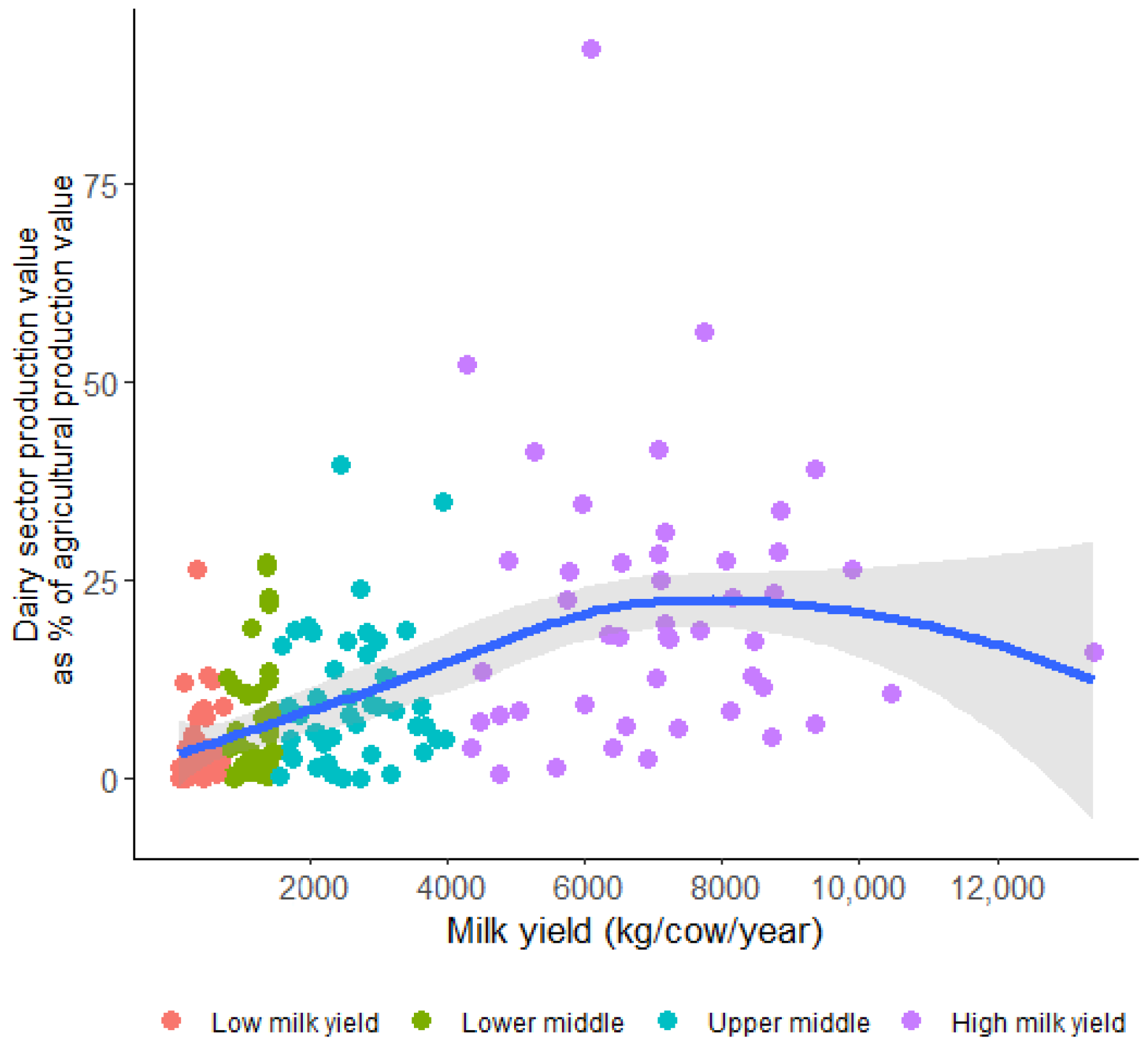
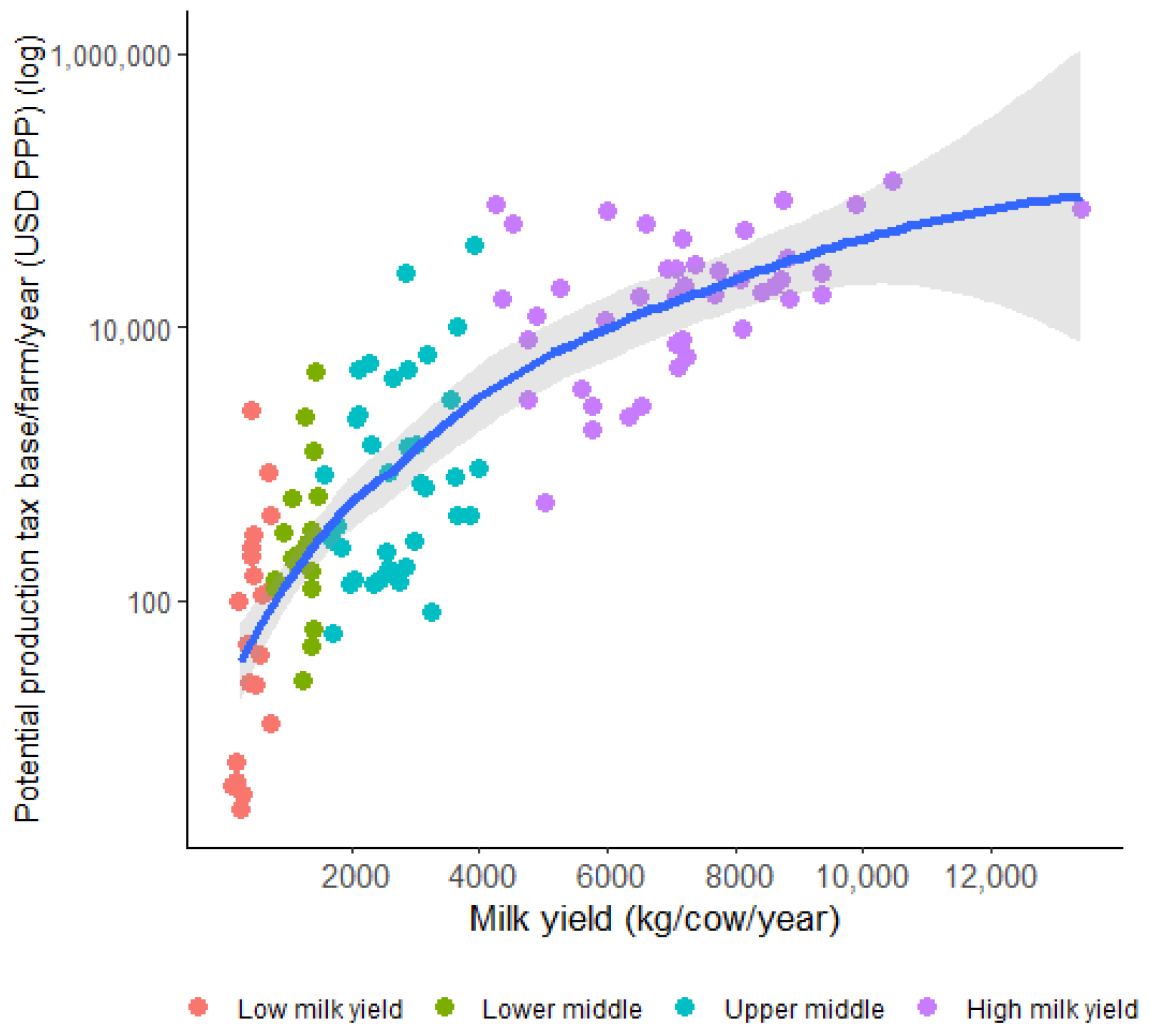
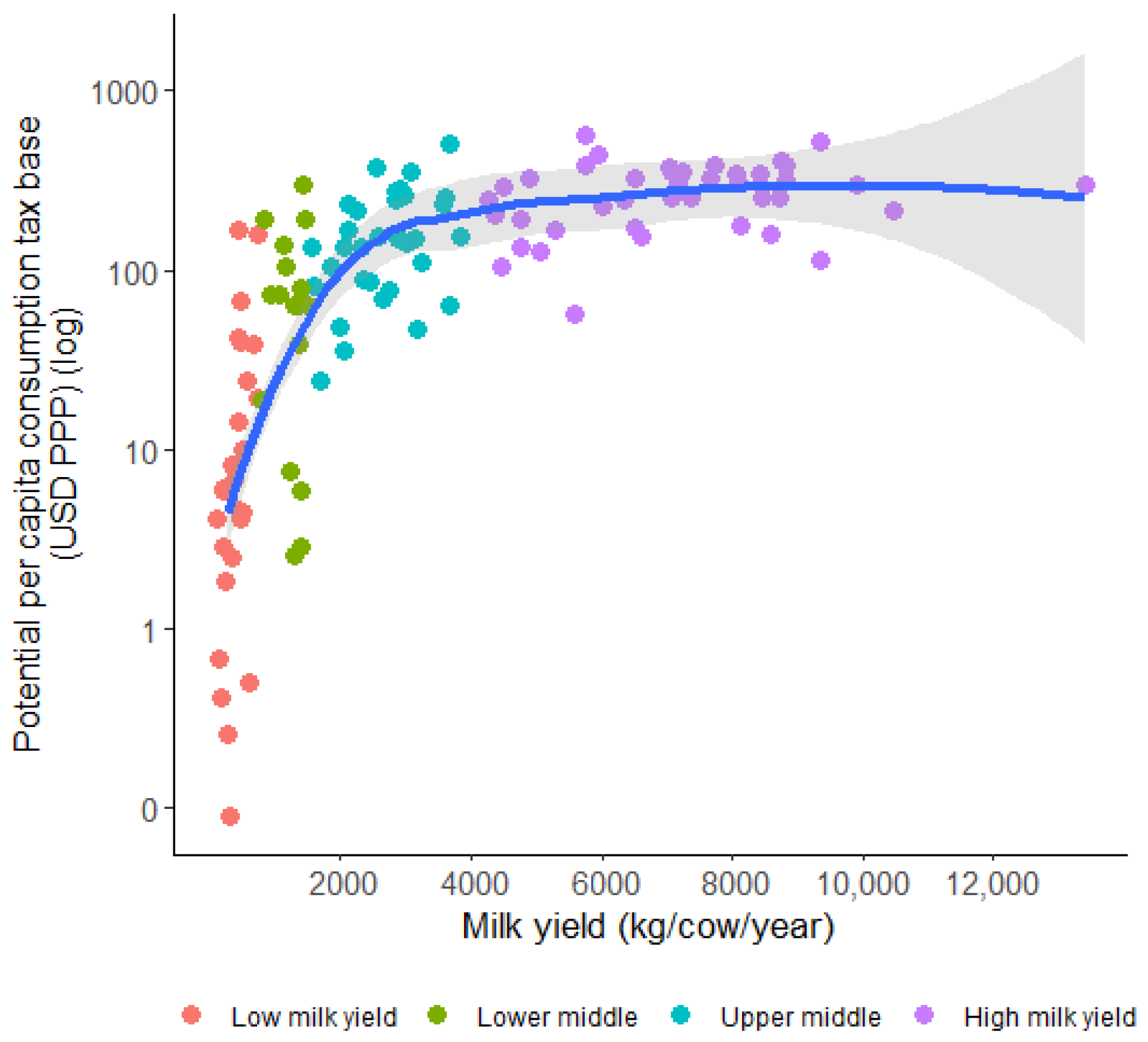
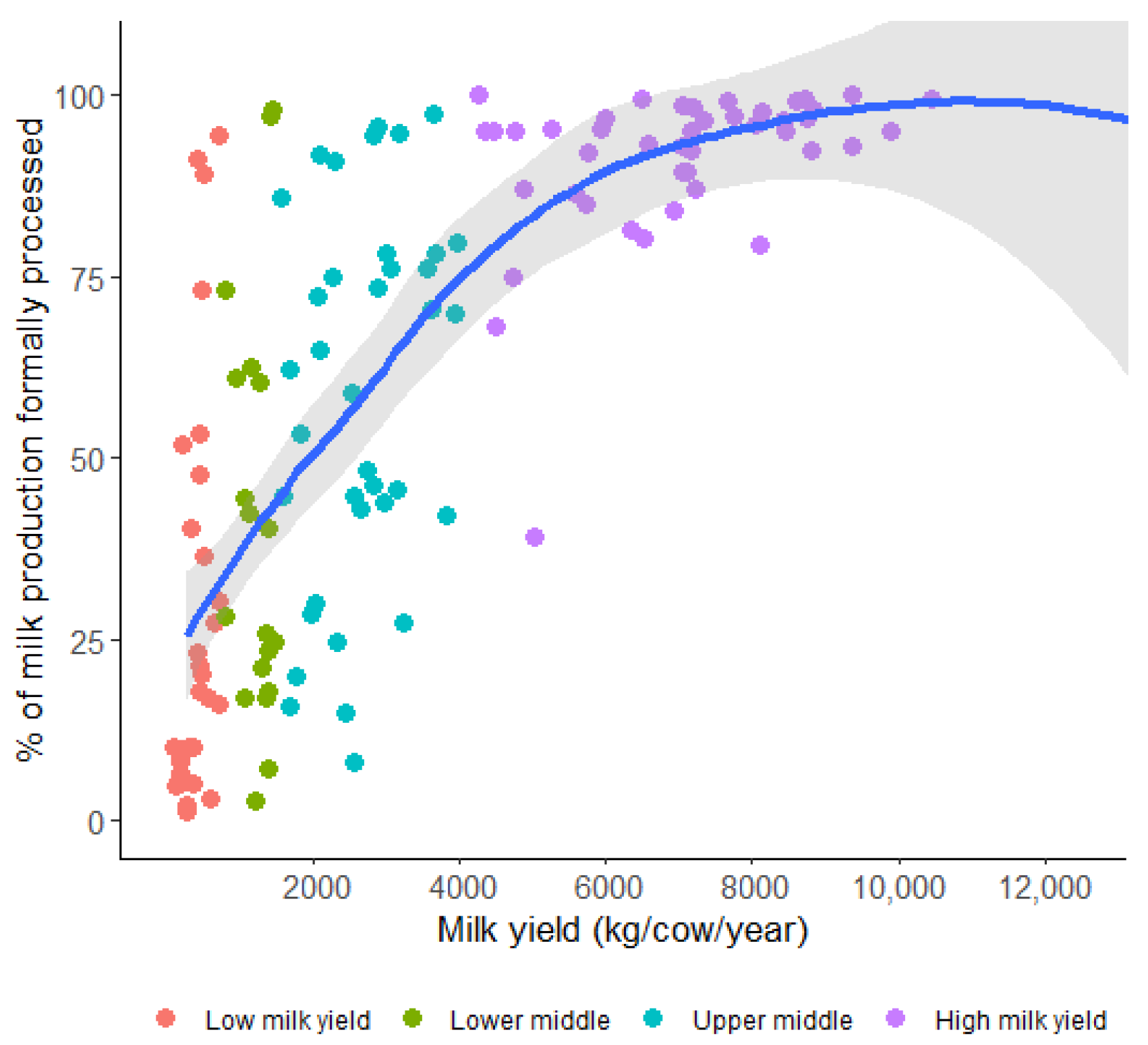
| Original Input Variables | Source |
|---|---|
| Regional classification | WB |
| Regional and subregional classification | ILO |
| Income classification | WB |
| Population | UNPF |
| GDP per capita | WB |
| International poverty line (IPL) | WB |
| Lower-middle-income countries’ poverty rate | WB |
| Upper-middle-income countries’ poverty rate | WB |
| High-income countries’ relative poverty line | WB |
| Dairy national estimates for national poverty line | WB |
| Number of dairy farms | IFCN * |
| Dairy animals | FAO |
| Milk yield | FAO |
| Milk production | FAO |
| Milk delivered to processors | IFCN * |
| Milk production gross value (cow) | FAO |
| Milk production gross value (buffalo) | FAO |
| Agriculture value added | FAO |
| Milk supply | FAO |
| Average family size | UNPF |
| No. of family labourers per farm | IFCN * |
| No. of hired labourers per farm | IFCN * |
| Share of informal employment by country | ILO |
| Share of informal employment by region and level dvlmnt (ILO and MODEL) | ILO, and literature-based |
| Dairy sector industry number of employees | UNIDO |
| Wages and salaries (dairy industry) | UNIDO |
| Average farmgate milk price LCU | FAO |
| Farmgate milk price in natural contents | IFCN * |
| Average retail price of 1 l milk | Numbeo |
| PPP conversion rate (GDP) | WB |
| Share of milk delivered to processors | IFCN * |
| Dairy imports | FAO |
| Dairy exports | FAO |
| Imports over domestic supply | FAO |
| Percentage of Households who Reported Having Consumed Fresh milk | WB |
| Percentage of Households who Reported Having Consumed Preserved milk and Other Milk Products | WB |
| Percentage of Households who Reported Having Consumed Cheese | WB |
| Percentage of Households who Reported Having Consumed Butter and Margarine | WB |
| Dairy consumption shares | Literature-based |
| Expenditure on milk, cheese, and eggs | WB |
| Dairy Sector Stylized Facts | Literature Assessment | Refs. on General Agricultural Sector |
|---|---|---|
| 1. Dairy Sector Development and Farmer Livelihoods | ||
| Stylized fact 1. Decreasing presence of dairy farm households in population. | Aligned/Plausible | Eurostat [44] (aligned); Lowder et al. [45] (plausible). |
| Stylized fact 2. Higher income for dairy farm households. | Aligned | Pinstrup-Andersen and Pandya-Lorch, [46]; Mozumdar [14]; Datt and Ravallion [47]; Christiaensen et al. [30]. |
| 2. Dairy Sector Development and Employment | ||
| Stylized fact 3. Higher milk yield correlates with fewer people working on dairy farms. | Aligned | Kuznets [48]; Timmer [29]; Hazell [49]; Lipton and Longhurst [50]; Irz et al. [13]; Gollin [51]; Heston et al. [52]; Eurostat [44]. |
| Stylized fact 4. Rising farm labour productivity. | Aligned | Dorward [53]; Briones and Felipe [54]; Gollin [51]; Yangfen et al. [55]. |
| Stylized fact 5. Employment pervasiveness in dairy processing facilities rises, peaks, then declines. | Aligned | Lipton and Longhurst [50]; Irz et al. [13]; Herrendorf et al. [56] * |
| Stylized fact 6. Increasing wages in milk processing. | Aligned | Hazell [49]; Irz et al. [13]. |
| 3. Dairy Sector Development and Consumption of Milk and Dairy Products | ||
| Stylized fact 7. Milk supply increases. | Aligned | Mozumdar [14], Alston et al. [57]; Fan and Brzeska [20]; Hazell and Ramasamy [58]; Pingali [15]; Webb [19]. |
| Stylized fact 8. More people access and consume dairy products. | Aligned | Barrett [16]; Lipton [59]; Conceição et al. [60]; Villacis et al. [61]; Kearney [62]. |
| Stylized fact 9. Greater benefits for consumers through lower prices. | Aligned | Barrett [16]; P. L. Pingali [15]; Irz et al. [13]; Dorward [53]. |
| Stylized fact 10. Better milk affordability. | Aligned | FAO et al. [63]; Herforth et al. [64] (and point 8 and 9 references). |
| 4. Dairy Sector Development and Governments’ Benefits | ||
| Stylized fact 11. Contribution to agricultural value addition increases. | Aligned | Hazell [21]; Blanco and Raurich [65]; Briones and Felipe [54]; Chavas [66]. |
| Stylized fact 12. Potential tax base (income) increases. | Aligned | Chang et al. [67]; Irz et al. [13]; Popoola et al. [68] +; Besley and Persson [69] * |
| Stylized fact 13. Potential tax base (consumption) increases. | Aligned | Irz et al. [13]. |
| Stylized fact 14. Formality growths. | No references/Plausible | Schneider et al. [70] *; Kouakou and Yeo [71] *; Feld and Schneider [72] *; Goel & Nelson [73] *; La Porta & Shleifer [74] *; Taymaz [75]. * |
| Factor | Wilks’ Lambda | Pillai’s Trace | Hotelling–Lawley |
|---|---|---|---|
| Region | 0.250 (0.000) *** | 0.873 (0.000) *** | 2.51 (0.000) *** |
| Income group | 0.257 (0.000) *** | 0.777 (0.000) *** | 2.75 (0.000) *** |
| Yield quantile | 0.509 (0.000) *** | 0.537 (0.000) *** | 0.875 (0.000) *** |
| Ecozone | 0.687 (0.029) * | 0.336 (0.033) * | 0.422 (0.026) * |
| Social Indicator | F Value | p-Value |
|---|---|---|
| Farmer Livelihoods | ||
| Presence of dairy farm households in population | 1.73 | 0.172 |
| Income for dairy farm households | 0.63 | 0.601 |
| Employment | ||
| People working on dairy farms | 0.61 | 0.614 |
| Farm labour productivity | 11.46 | 0.000 *** |
| Employment pervasiveness in dairy processing facilities | 3.57 | 0.019 * |
| Wages in milk processing | 2.05 | 0.117 |
| Consumption of milk and dairy products | ||
| Milk supply per capita | 1.23 | 0.306 |
| Population accessing and consuming dairy products | 7.26 | 0.000 *** |
| Price (milk retailer price) | 8.66 | 0.000 *** |
| Affordability (as share of salary) | 19.21 | 0.000 *** |
| Governments’ benefits | ||
| Contribution to agricultural value addition | 6.35 | 0.000 *** |
| Potential tax base (income) | 0.5 | 0.682 |
| Potential tax base (consumption) | 11.96 | 0.000 *** |
| Formality | 6.6 | 0.000 *** |
Disclaimer/Publisher’s Note: The statements, opinions and data contained in all publications are solely those of the individual author(s) and contributor(s) and not of MDPI and/or the editor(s). MDPI and/or the editor(s) disclaim responsibility for any injury to people or property resulting from any ideas, methods, instructions or products referred to in the content. |
© 2025 by the authors. Licensee MDPI, Basel, Switzerland. This article is an open access article distributed under the terms and conditions of the Creative Commons Attribution (CC BY) license (https://creativecommons.org/licenses/by/4.0/).
Share and Cite
Felis, A.; Pica-Ciamarra, U.; Reyes, E. Dairy’s Development and Socio-Economic Transformation: A Cross-Country Analysis. World 2025, 6, 105. https://doi.org/10.3390/world6030105
Felis A, Pica-Ciamarra U, Reyes E. Dairy’s Development and Socio-Economic Transformation: A Cross-Country Analysis. World. 2025; 6(3):105. https://doi.org/10.3390/world6030105
Chicago/Turabian StyleFelis, Ana, Ugo Pica-Ciamarra, and Ernesto Reyes. 2025. "Dairy’s Development and Socio-Economic Transformation: A Cross-Country Analysis" World 6, no. 3: 105. https://doi.org/10.3390/world6030105
APA StyleFelis, A., Pica-Ciamarra, U., & Reyes, E. (2025). Dairy’s Development and Socio-Economic Transformation: A Cross-Country Analysis. World, 6(3), 105. https://doi.org/10.3390/world6030105







